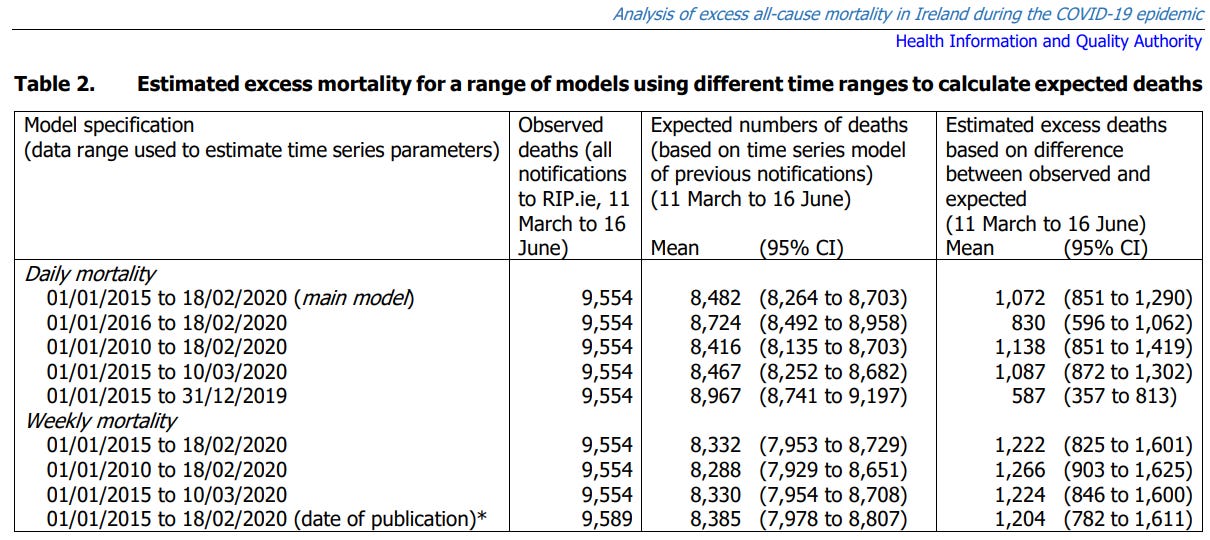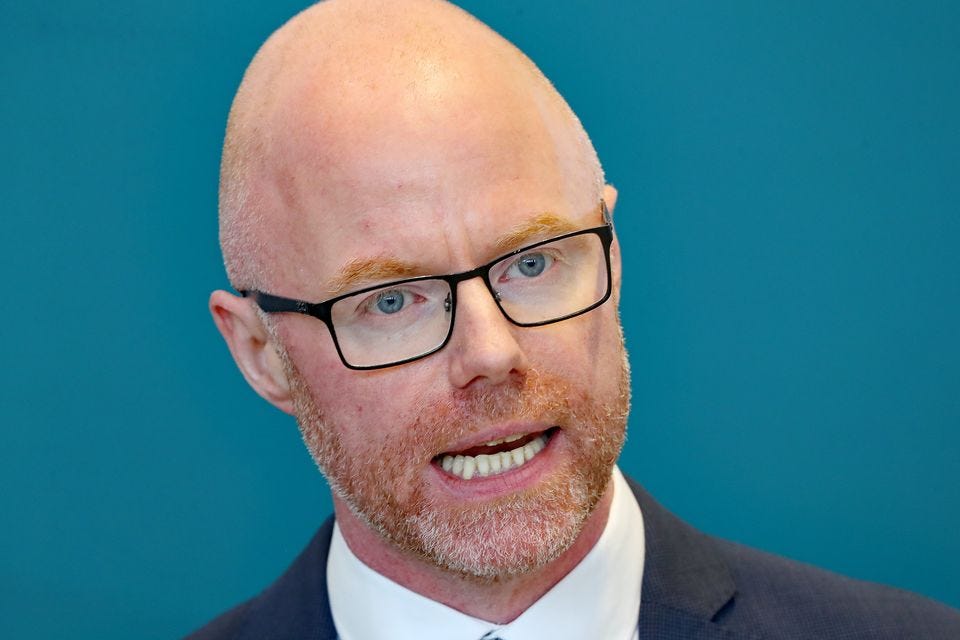Dear Minister
or How the Irish Minister of Health has misdirected public concerns over excess deaths
The Irish Minister for Health, Stephen Donnelly, has developed stock responses1234 to any queries from journalists or fellow politicians about the notable increase in funerals in Ireland since summer 2021. His responses have often made it seem there are no homegrown estimates of excess mortality available and the best he can offer is that his department monitors various third-party published estimates, from a range of different sources:
The Department of Health does not produce estimates of excess mortality.
However, the Department works closely with the Health Protection Surveillance Centre (HPSC) and other stakeholders to monitor estimates of excess mortality.
The Department closely monitors estimates of excess mortality which are published by a range of different sources.
The Department of Health will continue to actively monitor and review all available data on mortality as it becomes available.
“Works closely with” HSE?
For example, the above-mentioned Health Protection Surveillance Centre (HPSC), Ireland's specialist service for the surveillance of communicable diseases (equivalent to USA’s CDC), is part of the the Health Service Executive (HSE), and it is the Minister for Health and the Department of Health which have political responsibility for the health service. It therefore appears disingenuous to distance the HPSC’s work from the Minister’s own Department.
HPSC Weekly Mortality Reports
This presents a small contradiction because the HPSC does produce estimates of Irish excess mortality, doing so on a weekly basis.5 Receiving weekly deaths figures from the GRO and using a public source algorithm called A-MOMO developed for the European Mortality Monitoring group, the HPSC produces detailed, internal, weekly mortality reports and sends the generated z-score outputs (a measure of standard deviation) to the EuroMOMO group for aggregation and central publication of all participating European countries’ mortality data.
Here’s a sample from the HPSC’s Weekly Mortality Report for week 14, 2020, which was attached to a discussion document on the “Mortality Rate during the COVID-19 pandemic” by the National Public Health Emergency Team (NPHET) in April 2020 and marked confidential [highlighting original]:
Witzbold’s Newsletter has previously discussed criticisms of EuroMOMO’s modelling, nevertheless it is extremely improbable that the Department of Health cannot estimate Irish excess mortality from the weekly values of “Model Baseline”, “Known numb. deaths”, and “Adjusted numb. Deaths” produced by the HPSC. The A-MOMO model even provides a helpful feature for cumulative totals of weekly excess deaths estimates.
European Agencies
So, why has the Irish Minister for Health constantly referred to graphs published by the EuroMOMO group based in Denmark when the original estimates are produced in Dublin within the HSE, and more detailed mortality data is presented in its (internal) weekly mortality reports?
And why has the Minister repeatedly referred to Eurostat, the statistical office of the European Union, as a “source” producing estimates of excess mortality in Ireland, when it, in turn, receives its Irish mortality data from the Central Statistics Office in Ireland?
Because of the COVID-19 pandemic, the Central Statistics Office (CSO) of Ireland began to explore experimental ways of obtaining up-to-date mortality data. At the end of April 2021, CSO started publishing a time series from October 2019 until the most recent weeks, using death notices (see CSO website). For the purpose of this release, Eurostat is comparing the new 2020-2021 web-scraped series with a 2016-2019 baseline built using official data. CSO is periodically assessing the quality of these data.6
The Irish CSO has even presented the exact same methodology of averaging a predictive baseline from a prior 4-year period in its latest report on measuring mortality using public data sources. So why defer to estimates published outside of the state, and why the suggestion that Irish authorities have no control over those estimates? Here the CSO presents different 4-year ranges for comparison:

Reporting to the Minister of Health
Similarly, the Health Information and Quality Authority (HIQA, an independent Irish statutory authority reporting to the Minister for Health produced in July 2020 an “Analysis of excess all-cause mortality in Ireland during the COVID-19 epidemic” for the period March 11- June 16 2020, also using data from Ireland’s death notices website RIP.ie.
[Note, I do not agree with HIQA’s estimates as it has regrettably used incomplete actual deaths totals from previous years and has myopically constrained its estimates to an arbitrarily long 14-week period centered around the first wave of deaths in Mach-April 2020 without considering the wider seasonal picture: i.e. Q1 2020 was arguably below trend and Q3 was most definitely below trend. Thus, the phenomenon of mortality displacement has seemingly been ignored, whereby the vulnerable who didn’t die in Q1 may be reasonably expected to die in Q2 and those who died in Q2 can no longer die in Q3.]

In a subsequent report entitled, “Descriptive analysis of COVID-19 epidemiological indicators and associated contextual factors in European countries”, the HIQA abandons the novel method of using near real-time death notices from RIP.ie instead reverting to the A-MOMO model already employed by the HPSC and EuroMOMO (based on incomplete, delayed GRO death registrations). That report constrains its analysis to an arbitrarily long 90-week period representing neither complete calendar years nor mortality years and stops short before the substantial excess deaths seen in Winter 2021/22.
Yes, Minister
This speaks to two recurring phenomenons in explorations of the actual excess mortality data: first, disturbing or unexpected trends are deemed unimportant, relativised, or ignored - especially if a similar trend can be presented in other European countries; second, the parameters of analysis are adjusted to fit an expected result or narrative - in this case, that Ireland experienced notable excess mortality during the pandemic but less so than other countries.
Consider the following statement by Stephen Donnelly’s colleague, the Minister of State at the Department of Health (Hildegarde Naughton), during a parliament debate entitled, “Trends in Mortality and Estimates of Excess Mortality” [Witzbold’s emphasis]:
“Ireland’s age-standardised all cause death rate declined steadily from 1,152 deaths per 100,000 in 2007 to 923 per 100,000 in 2019. In 2022, the provisional age-standardised all cause death rate was 937 per 100,000. While this was an increase from 2021, it was below the age-standardised all cause death rate of years prior to 2018. As most causes of death vary significantly with people's age and sex, the use of standardised death rates improves comparability over time and between countries.”7
This type of verbal misdirection is reminiscent of a used-car salesman. The Minister of State states mortality rates had been falling and references Ireland’s mortality in 2019, before skipping the rates for 2020 and 2021, only to highlight a provisional (by my calculations, representing a significant underestimation) rate for 2022. She then contrasts the provisional 2022 rate with rates from 5 years previously in 2017 (and earlier) in order to fob off any concerns of alarming trends in Ireland’s 2021/22-2022/23 mortality rates. See? Everything’s ok!
An honest statement should have read [Witzbold’s take]:
Ireland’s age-standardised all cause death rate declined steadily for over a decade until 2020/21. While provisional age-standardised all-cause death rates for 2021/22 and 2022/23 remain below levels from 2017/18 and earlier years, the trend of falling death rates has been reversed since July 2021. We don’t know why, and we don’t care to find out.
As most causes of death vary significantly with people's age and sex, the use of standardised death rates improves comparability over time and between countries but only if reliable population figures and deaths totals are available (and applied) - and my government is not interested in that sort of thing.
Meanwhile, Stephen Donnelly, despite having been repeatedly questioned during 2023 about recent winter excess mortality rates (i.e. 2021/22, 2022/23), at a press conference from October 2023 he feigns ignorance of mortality trends since the pandemic:
Minister of Health: I’m happy to look at analysis, Ben [reporter’s name]. What I can say is that the analysis that I have seen, which is from the Lancet, which looks right across the world, in terms of the Covid period, has Ireland as having one of the lowest levels of excess mortality anywhere in the world - something I think we're all extremely grateful for and [is] a proud reflection of our health services. And, if there are figures in terms of post that, where there are excess mortality figures, I'm more than happy to take a look. But it's not something that I could give you a give you a a solid answer on.
Reporter: So, we still don't have any kind of theories or solid ideas as to what might have caused that in, again, the past winter, and then in some of the months after that?
Minister of Health: First of all, I don't know to what extent your assertion is correct - you may well be correct, but I'd need to see the data to look at whether or not there has been excess mortality, and the implications of that. So, it's not something I can give you an analytical response on that.
That’s right, he referenced a study about 2020-2021 in response to a question about excess mortality in 2022-2023
Lancing that Lancet Study
The Minister has developed a liking for studies and analyses looking at excess mortality in Ireland during the pandemic years of 2020-2021 (which almost invariably have used incomplete data in their estimates or aggregate multiple seasons thereby missing the concerning rise in monthly mortality starting since July 2021). In the above video clip, the Minister referenced a Lancet study, which according to Donnelly shows8 :
Ireland was among several European countries (including Iceland, Norway, and Cyprus) which had some of the lowest rates in the world, at less than 50 excess deaths per 100,000 population.
Firstly, crude rates are not directly comparable between nations because of variations in population structure. Ireland has one of the youngest populations in Europe, having a significantly smaller proportion of its population over 65 or 80, albeit a rapdly growing and aging population. As senior statistician Dr. Kevin McCormack at the CSO has highlighted:
“The crude death rate does not provide a great deal of information about mortality. In particular, the risk of dying varies greatly with age, and the crude death rate indicates nothing about this variation. Because of this age-specific death rates are used.”
Secondly, just glancing through the Lancet study makes it apparent the authors have tried to apply a one-size-fits-all model to countries and regions included, taking scant account of national/regional trends, nor varying population structures. As evidenced by my previous post on German excess mortality shenanigans, Lancet’s estimate of excess deaths for Germany is a gross over-estimation to the point it is questionable whether this study can be taken seriously. Of course, the Minister is happy to take it seriously because it makes Irish mortality during the pandemic look good by comparison.
Raw Irish Mortality Data
Any estimates of Irish excess mortality are ultimately made based on raw data collected, recorded, processed, and made available by the following Irish authorities:
General Register Office (GRO) - responsible for recording all registered deaths, publishes weekly data to the Deaths Events System (DES), allowing approved Public Service bodies to gain access to data on all deaths registered with the General Register Office.
Health Protection Surveillance Centre (HPSC) - uses weekly deaths data from GRO to produce an internal Weekly Mortality Report and also produces a weekly Influenza Surveillance Report including a section on all-cause mortality surveillance. Weekly z-score outputs from the A-MOMO algorithm are submitted to the European Mortality Monitoring group.
Central Statistics Office (CSO) Receives quarterly deaths data directly from the GRO, analyses and makes available statistics on deaths in Ireland in various reports and databases. Has also undertaken a comprehensive analysis of measuring mortality using public data source, RIP.ie, an online death notices platform, and submits weekly cleaned deaths totals from RIP.ie to Eurostat.
What’s stopping you, Minister?
Even if we indulge the Minister’s semantics that his Department does not produce estimates of Irish excess mortality, there is nothing stopping him from instructing it to do so. Neither is there anything stopping the Minister from requesting age-specific estimates from the Irish public bodies which are already supplying mortality data to the third parties that he prefers to reference at arm’s length. He could equally request information from coroner’s offices around the country asking for a tally of coroner’s certificates pending for deaths occurring in 2020, 2021, 2022, and 2023 in order to clear up the uncertainty regarding incomplete deaths totals.
Indeed, if the Minister wanted provisional in-house estimates of excess mortality to be on his desk in the morning, he could simply ask the dedicated Statistics and Analytics Unit within his own Department of Health. The Statistics and Analytics Unit “aims to strengthen evidenced-based policy-making through improved availability and use of information”. This unit has previously prepared age-specified mortality rates and regularly publishes age-standardised all-cause mortality rates (see Table 2.4) using CSO data (unfortunately from incomplete deaths totals and unadjusted cohort populations). There is little else required to make estimates of excess mortality other than to qualify any assumptions or methodology used to calculated the expected baseline values.
Just as in the case of Destatis, the Federal Statistical Agency in Germany, I have no doubt of the professional competence of the statisticians at the Irish Central Statistics Office or the Statistics and Analytics Unit of the Department of Health, and thus it begs the question: why are there no appropriately adjusted estimates of excess deaths in Ireland taking account of the various confounders previously discussed at length in this substack (i.e. trends in population growth, population structure, and life expectancy)?
World Health Organisation
Finally, the Minister puzzlingly dropped the following graphic from the World Health Organisation into the end of his written response to a question from a sitting member of parliament within his own party on 18th January 2023.
WHO published (5 May 2022) a report estimating ‘Global excess deaths associated with COVID-19, January 2020 - December 2021’. This report estimated excess mortality associated directly (due to the disease) or indirectly with the COVID-19 pandemic (e.g. due to the pandemic’s impact on health systems and society) between 1 January 2020 and 31 December 2021.
Its estimations aren’t all that bad: [Witzbold’s edits - red bars and blue arrows to indicate mortality years]

Note the steadily climbing curve from July onward in 2021. While the overall magnitude of the cumulative excess deaths in the pandemic period 2020-2021 in comparison to other countries may be something the Minister for Health is proud of, he ignores that over 50% of the excess deaths occurred in just six months in the second half of 2021.
According to the WHO’s estimates, when dividing by mortality years (July-June), it can clearly be seen that Ireland saw minimal excess deaths in the fist half of 2020 (~700 after normal levels in second half of 2019); minimal excess deaths in 2020/21 (~700 equating to ~2% of mortality year total); but in the second half of 2021 alone it saw ~1500 excess deaths - over double that of the entire pandemic mortality year 2020/21 and more than the entire pandemic period January 2020 to June 2021, which featured the substantial peaks in deaths of April 2020 and Winter 2020/21.
Summary
To answer the many rhetorical questions posed in this post: Why? - One starts to get the impression there is no political will to prepare and produce accurate excess mortality estimations in Ireland because the results would be uncomfortable reading. The actual data contradicts the prevailing narratives which so many cling to like soothing security blankets and yet others clasp like masks or shields to hide behind and defend their failed pandemic policies and behaviour.
The story has become not if the country has seen an unexpected rise in mortality rates since the pandemic (it clearly has) but a story of the government’s and mainstream media’s obtuseness in the face of this reality of actual higher mortality, standing in stark contrast to their naked peddling of fear and panic in the face of projected excess deaths during the pandemic.
My research, based primarily on publicly available CSO and GRO data, has shown no unusual overall levels of excess deaths in Ireland in the mortality years 2019/20 and 2020/21. Note, 2018/19 was a so-called deficit year and so an increase or reversion to trend was to be expected in 2020. There certainly were peaks of excess deaths in particular weeks/months of 2020 and 2021 but, along the lines of mortality displacement, this must be placed in the full context of mortality years for final assessment.
True trends in imperfect/incomplete data
As highlighted in Excess Deaths: The Slow Burn, incomplete/imperfect data can still be used to identify and locate true trends providing there is consistency in the data collection. As also highlighted in A Nation Grows Older: Disparate Mortality Trends and Other Demographic Curiosities, the magnitude of the mortality rates in Ireland is not in itself alarming when compared to Irish mortality rates of just a few years prior to the pandemic, but what is concerning is the reversal of trend from falling death rates to rising death rates.
Starting since July 2021, counter-intuitively in the middle of summer, there has been near continuous elevated levels of mortality until at least Q2 2023 - as evidenced by CSO’s analysis of public death notices. The jury may be still out on what has caused the post-pandemic increases - cancelled doctors visits, delayed treatments, chronic stress, depression, less healthy pandemic lifestyles, Covid-19, Long-Covid, vaccinations, climate change 😉, you name it - but make no mistake, the mainstream media, politicians, and even fellow citizens don’t care for an honest examination because they too are complicit.
==Follow up post==
Happy New Year
The Irish Department of Health launched its new year (mis)communications with a successful media blitz capturing front page headlines of just about every mainstream national newspaper and media organisation across the island. Its Orwellian new year message puzzlingly contradicted previous wall-to-wall established media coverage during and immediately af…
https://assets.gov.ie/228637/678bf0f6-8c62-4845-bb9d-affd7c2a816a.pdf
See footnote 1
See footnote 1











Excellent piece, my friend!
Brief Q: what's the Irish public health officialdom's definition of a 'Covid-associated death'? As you may know, the Norwegians don't have a consistent definition (i.e., it changed over time), and by now one doesn't even have to have Covid or even tested 'positive' for it. As regards that little notion, all testing data is invalid for lack of baselines, sample groups, repeat testing by Branch Covidians vs. those who couldn't care less, etc.
Long-ish A w/respect to the 'why?' you ask about at the end: you point to all correct things, I think, but here's my hunch--getting jabbed 'pulls death forward' by an unspecified amount of time; moreover, it looks as if the artificial S proteins exacerbate all and any pre-existing health-related issues that may have gone unnoticed for a long time or forever.
My suspicion is it's not only a question about who and why doesn't anyone want to move first--I think it's a game of chicken, so to speak--but there's nothing to gain. You know, back in the 1960s, speaking out against, e.g., the war in Vietnam might have helped end the conflict; by contrast, today, no-one 'wins' anything: Big Pharma surely has no interest (to put it mildly), and neither to the other complicit parties, from politicians to consultants, from 'public health experts™' to 'journalists' in legacy media, and from doctors to the courts. They've all got a stake in never being found out, hence they will fight this tooth, nail, and then some.
"Health Protection Surveillance Centre " -how creepy.Another arm of the Government dedicated to Military Industrial Complex against citizenry.